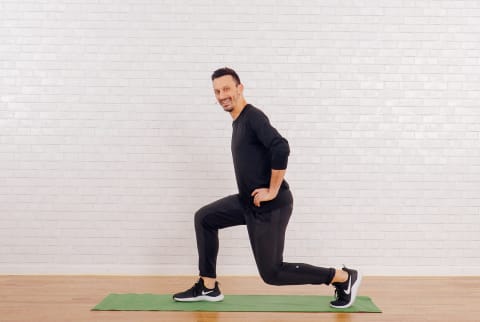Advertisement
How To Do Split Squats Properly & Fire Up Your Lower Body


If you're looking for a simple move that's sure to work your glutes and quads, you'll definitely want to try split squats. Split squats fire up your lower body, don't require any equipment (unless you want to level up the challenge), and you can modify the exercise to meet your needs. Here's how to do this move properly—plus tips, modifications, and the benefits—according to NASM-certified personal trainer BB Arrington, CPT (demonstrated below by fitness instructor Dino Malvone).
How to do split squats:
- Start in a standing position, then step your left leg behind you. This is your starting position.
- Hinge slightly at your hips, bend your knees, and lower down. Keep your back heel up and your front heel down. Engage your glutes and quads to come back up to start.
- That's one rep. Complete 10, then repeat on the right side.
Form tips:
- Placing the front foot on a slightly elevated surface while the back ball of foot remains on the floor will allow more depth and range of motion in the front hip and glute, Arrington says.
- Placing the heel of the front foot on a slightly elevated surface while the back foot and front toes remain on the floor, according to Arrington, will give you more depth and range of motion to challenge your front quad more.
- Placing the ball of your foot on the bag leg on a slightly elevated surface brings more attention to the back leg's quad.
- Be sure to push the front knee forward, tracking in line with the toes.
Modifications & variations:
If you feel this move in your lower back, double-check that you are truly bending your back leg a lot, and double-check that your stance isn't too wide, Arrington says.
To level up this move, Arrington recommends holding the bottom position for two or three counts—which also emphasizes the eccentric (lengthening) portion of the exercise. What's more, holding a weight in your hand, on the same side as your back leg, can also make this more challenging.
There are a number of split squat variations, but one of the most popular is the Bulgarian split squat. This exercise involves elevating your back foot on a raised surface (demonstrated below by Arrington). As mentioned, this variation can help emphasize activation in your back quad.
What are the benefits?
As Arrington explains, split squats have a lot of benefits, namely working your quads and glutes. They're also a good way to replicate the hip and knee flexion of the bottom position of a squat, she adds.
And because they're a unilateral (one-sided) move, you'll need adequate balance. Tapping into your core will help maintain that stability—so this exercise tests not only your balance but also your core strength.
The bottom line is, split squats don't require any equipment, they're beginner-friendly, and you can make them more challenging if you so desire. In just a few minutes, your quads and glutes are sure to feel the burn, so make sure you don't miss out on this move next time you hit the gym.